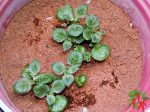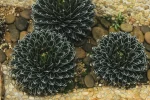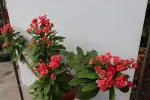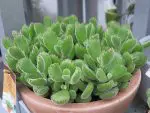This post contains affiliate links. If you buy something from one of our links we may earn a commission. Thanks
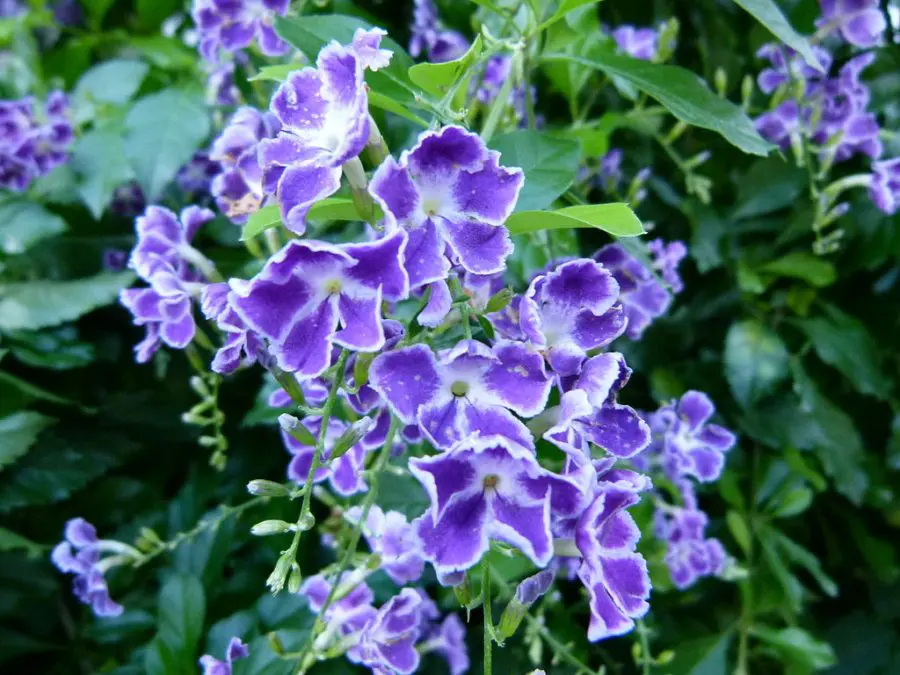
Discover the joys of growing Duranta in pots with our easy-to-follow guide, covering everything from light requirements to pest control for thriving plants.
Growing Duranta or Golden Dewdrop in pots is a straightforward process. This ornamental shrub prefers well-drained soil and a sunny to partly shaded location. Water moderately but consistently, and use a balanced fertilizer to encourage both foliage and flower growth. The potted Duranta is ideal for patios, balconies, and even as an indoor plant.
Are you looking to add a touch of tropical charm to your indoor or outdoor space? Growing Duranta in pots is a fantastic way to achieve just that!
These beautiful, versatile plants, also known as Golden Dewdrops, Pigeon Berries, or Skyflowers, can be a delightful addition to your garden or home.
In this comprehensive guide, we’ll walk you through everything you need to know about nurturing your Duranta plants to thrive and bloom, bringing a burst of color and life to your surroundings.
An Introduction To Growing Duranta in Pots
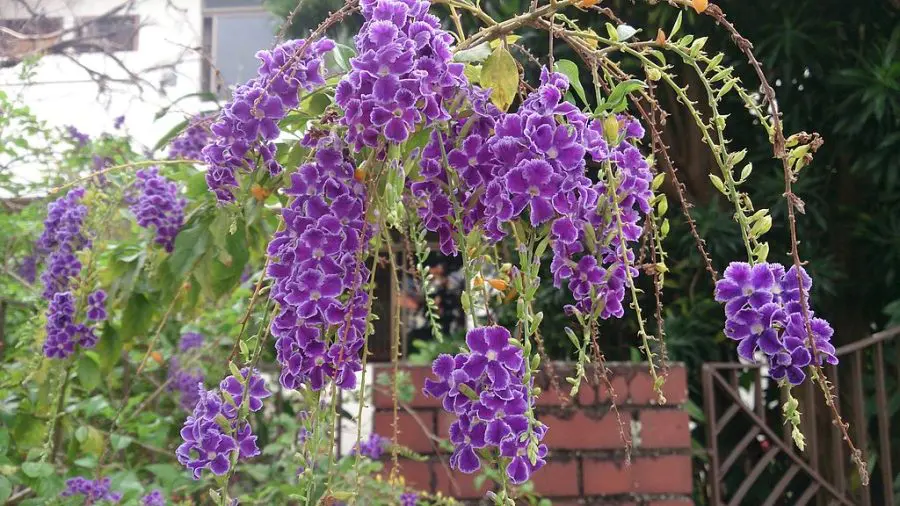
Duranta erecta is a species of flowering shrub in the verbena family Verbenaceae, native from Mexico to South America and the Caribbean. It is widely cultivated as an ornamental plant in tropical and subtropical gardens throughout the world, and has become naturalized in many places. Common names include golden dewdrop, pigeon berry, and skyflower. https://en.wikipedia.org/wiki/Duranta_erecta
Ready to embark on a delightful gardening adventure? Growing Duranta in pots is the perfect way to bring the vibrant hues and tropical vibes of golden dewdrops right into your own living space or garden.
In this introduction, we’ll familiarize you with Duranta erecta, its captivating features, and why cultivating these lovely plants in pots is an excellent choice for urban dwellers and small-space garden enthusiasts alike.
So, let’s dive in and explore the fascinating world of Duranta plants together!
Getting to Know Duranta erecta: The Vibrant Beauty
Let’s take a moment to appreciate the stunning beauty of Duranta erecta, which goes by many charming names such as golden dewdrop, pigeon berry, and skyflower.
This flowering shrub or small tree belongs to the verbena family Verbenaceae and is native to regions from Mexico to South America and the Caribbean.
When grown in pots, these plants can be an enchanting addition to your indoor or outdoor space, showcasing gorgeous light blue or lavender flowers that bloom in tight clusters during the summer.
The Perks of Pot-Grown Duranta: Urban and Small Space Gardening
Growing Duranta in pots has become increasingly popular, especially among urban dwellers and small-space garden enthusiasts.
Cultivating these plants in containers offers numerous advantages.
Firstly, it allows you to maximize limited space by placing them on balconies, patios, or even indoors.
Secondly, pot-grown Durantas give you greater control over their growing conditions, including soil composition and moisture levels.
Lastly, for those living in cooler climates, having Duranta in pots makes it easier to move them indoors during winter, ensuring their survival and health.
Indoor Benefits of Growing Duranta in Pots
Are you wondering what makes growing Duranta in pots such a delightful endeavor, especially for indoor spaces?
Well, let us shed some light on the various perks these charming plants have to offer.
Apart from their undeniable beauty, Duranta plants also provide a host of indoor benefits that can elevate your living space and overall experience.
In this section, we’ll explore these advantages, ranging from aesthetic appeal to air purification and more, helping you understand why welcoming a Duranta plant into your home is a fantastic choice.
So, let’s dive in and uncover the indoor wonders of pot-grown Durantas!
A Feast for the Eyes: Aesthetics and Visual Appeal
One of the most compelling reasons to grow Duranta in pots indoors is their incredible aesthetic value.
The vibrant light blue or lavender flowers that adorn these plants create a stunning visual impact, making them a great addition to any room.
Additionally, their cascading clusters of flowers can provide a lively burst of color and create a focal point in your living space, brightening up even the dullest of corners.
Breathing Easy: Air Purification
Apart from their beauty, Duranta plants also contribute to cleaner indoor air.
Like many other plants, Durantas absorb carbon dioxide and release oxygen, promoting a healthier living environment.
Although they may not be as effective as some other well-known air-purifying plants, their presence still contributes to a fresher and more pleasant atmosphere in your home.
Welcoming Winged Wonders: Attraction of Pollinators
While growing Duranta plants indoors may not attract as many pollinators as they would when grown outdoors, having them in your home still offers the chance of occasional visits from butterflies and hummingbirds when placed near open windows or in outdoor living spaces during warmer months.
These delightful creatures are not only fascinating to observe but also play a crucial role in maintaining biodiversity and ensuring the health of our ecosystem.
So, by growing Duranta in pots, you’re doing your part to support these essential pollinators.
Plant Size and Growth Rate
Curious about how big your Duranta plants can grow and how fast they’ll reach their full potential?
In this section, we’ll dive into the fascinating world of plant size and growth rate for Durantas cultivated in pots.
Understanding these aspects will help you provide the best possible care for your beautiful plants, ensuring they have ample space to flourish and thrive.
So, join us as we explore the ins and outs of Duranta size and growth, guiding you to become a knowledgeable and confident caretaker of these lovely tropical gems.
Compact Charm: Typical Size When Grown in Pots
When it comes to growing Duranta in pots, you can expect a more compact size compared to those planted in the ground. This makes them an excellent potted plant.
While Duranta is a fast-growing plant and can grow up to 6 meters (20 feet) tall and spread to an equal width in their natural habitat, pot-grown Durantas usually stay within a more manageable size range of 1 to 3 meters (3 to 10 feet) in both height and width.
This makes them an excellent choice for small spaces or as an indoor ornamental plant, offering a lovely tropical vibe without overwhelming the area.
Steady Progress: Growth Rate and Factors Affecting It
Duranta plants are known for being a moderate to fast-growing plant, depending on various factors such as light, soil, and overall care.
In general, you can expect your potted Duranta to grow at a rate of around 30 cm (1 foot) per year, though some factors can significantly influence this pace.
Full sun, proper watering, well-drained soil, and timely fertilization all play a role in ensuring a healthy growth rate for your Duranta plants.
By carefully monitoring and providing the best possible conditions, you can help your potted Durantas flourish and reach their full potential in no time.
Light Requirements
Wondering how much sunlight your Duranta plants need to truly thrive? In this section, we’ll shed some light on the optimal illumination conditions for these stunning tropical beauties.
By understanding the importance of light and how to provide just the right amount for your Duranta plants, you’ll be well on your way to cultivating a vibrant, flourishing addition to your home or garden.
So, let’s delve into the world of light requirements and learn how to keep your Duranta plants happy, healthy, and glowing with radiant blooms.
Basking in the Sun: Ideal Sunlight Exposure
Duranta plants are true sun-lovers, which means they thrive when exposed to ample sunlight.
Ideally, they should receive at least 6 to 8 hours of bright, direct sunlight each day.
This generous dose of sunshine not only helps them grow strong and healthy but also encourages the production of their stunning blooms.
Keep in mind that while Durantas can tolerate partial shade, too little sunlight can lead to leggy growth and fewer flowers.
Bright Ideas: Tips for Providing Adequate Light Indoors
Ensuring your indoor Duranta plants receive enough sunlight can be a bit of a challenge, but with some clever planning, it’s entirely possible.
Here are some tips to help you provide adequate light for your potted Durantas indoors:
• Place your plants near a south-facing or west-facing window, where they can receive plenty of bright, direct sunlight.
• Rotate the pot every few weeks to ensure all sides of the plant get equal exposure to sunlight, promoting even growth.
• If natural light is insufficient, consider using artificial grow lights to supplement your Duranta’s light needs.
LED or fluorescent grow lights can be an effective solution, just make sure to follow the manufacturer’s recommendations for distance and duration.
• Be mindful of seasonal changes and adjust your plant’s location accordingly. As the angle of the sun shifts throughout the year, you might need to move your Duranta to a different spot to ensure it continues receiving enough light.
Watering
Navigating the world of watering can be a bit tricky, especially when it comes to keeping your Duranta plants happy and well-hydrated.
We’re here to help you find the perfect balance! In this section, we’ll explore the ins and outs of watering your potted Durantas, providing essential tips and insights to ensure your plants stay healthy, vibrant, and full of life.
So, grab your watering can, and let’s dive into the art of quenching your Duranta plants’ thirst in the most effective way possible.
Quenching Their Thirst: Watering Frequency
Duranta plants prefer evenly moist soil, but it’s essential to avoid overwatering.
In general, you should water your potted Durantas when the top inch of the soil feels dry to the touch.
Depending on the size of the pot, the type of soil, and the environmental conditions, this might mean watering every few days to once a week.
Keep in mind that Durantas may require more frequent watering during hot or dry periods, while less frequent watering is needed during cooler months or periods of low light.
Reading the Signs: Overwatering and Underwatering
It’s crucial to recognize the symptoms of both overwatering and underwatering in your Duranta plants. Here are some signs to look out for:
Overwatering: Yellowing leaves, root rot, and wilting even when the soil is wet are common indicators of overwatering. Prolonged overwatering can lead to fungal infections and the decline of your plant’s overall health.
Underwatering: Wilted or drooping leaves, dry soil, and slow growth are signs that your Duranta might not be getting enough water. Prolonged underwatering can cause leaf drop and may ultimately lead to your plant’s demise.
Keeping Things Balanced: Tips for Maintaining Proper Moisture Levels
To ensure your Duranta plants receive just the right amount of water, follow these tips:
• Use a well-draining potting mix, preferably with added perlite or coarse sand, to allow excess water to escape and prevent root rot.
• Make sure your pots have drainage holes to allow excess water to escape. If your pot doesn’t have holes, consider repotting your Duranta into one that does or add a layer of gravel at the bottom to improve drainage.
• Water your Duranta plants thoroughly, allowing the water to run through the drainage holes. This ensures that the root system receives enough moisture.
• Avoid letting your plants sit in standing water. Empty the saucer beneath the pot if water accumulates after watering.
• Adjust your watering schedule based on the season, temperature, and humidity. Durantas typically need more water during the warmer months and less during the colder ones.
Soil and Pots (Using Coco Coir)
The right soil type and pot can make all the difference when it comes to growing Duranta plants successfully. They typically grow in sandy or rocky soils with good drainage.
In this section, we’ll explore the wonderful world of coco coir – an excellent choice for potting Durantas – and discuss how to select the perfect pot to ensure your plants thrive.
By understanding the importance of proper soil composition and container selection, you’ll be well-equipped to create the perfect environment for your Duranta plants to flourish.
So, let’s dive in and learn how to set your potted Durantas up for success!
Coir to the Rescue: Advantages of Using Coco Coir as a Growing Medium
Coco coir, made from the fibrous husks of coconuts, offers several benefits as a growing medium for your Duranta plants.
Some advantages of using coco coir include:
• Excellent water retention: Coco coir can hold up to 10 times its weight in water, ensuring your Duranta plants have consistent access to moisture without the risk of waterlogged roots.
• Good aeration: The natural fibrous structure of coco coir allows for better air circulation around the roots, promoting healthy root growth and reducing the chances of root rot.
• Sustainable and eco-friendly: Coco coir is a renewable resource and an environmentally friendly alternative to peat moss, which takes thousands of years to form and is harvested from sensitive ecosystems.
Laying the Foundation: Preparing the Pot and Drainage
Choosing the right pot and ensuring proper drainage is essential for the health of your Duranta plants.
Here are some tips to help you prepare the ideal potting environment:
• Select a pot that is at least 2-3 inches larger in diameter than your Duranta plant’s root ball to allow for growth.
• Make sure the pot has drainage holes to allow excess water to escape, preventing root rot and other water-related issues.
• Consider using a saucer or tray beneath the pot to catch any excess water and protect your surfaces.
The Perfect Blend: Mixing Coco Coir with Other Soil Components for Optimal Growth
While coco coir is a fantastic growing medium on its own, mixing it with other soil components can create an even better environment for your Duranta plants to thrive.
Here’s a simple recipe for a well-draining and nutrient-rich potting mix:
• Start with a base of equal parts coco coir and high-quality potting soil.
Add perlite, coarse sand, or pumice to improve drainage and aeration. Aim for about 20-30% of the total mix volume.
• Mix in a slow-release fertilizer or well-composted organic matter to provide additional nutrients for your Duranta plants.
• Combine these ingredients thoroughly, then fill your pot with the mix, leaving enough space for your Duranta’s root ball. This custom blend will help your Duranta plants grow strong, healthy, and full of life!
• You can also consider adding worm castings to this mix or a slow-release fertilizer according to directions.
Fertilizing
Feeding your Duranta plants with the right nutrients is crucial for maintaining their health and encouraging those beautiful blooms.
In this section, we’ll discuss the ins and outs of fertilizing your potted Durantas, sharing valuable tips and recommendations to ensure your plants receive the nourishment they need to truly thrive.
So, let’s get ready to feed your Durantas the nutrients they crave and watch them flourish before your very eyes!
Feeding Time: Recommended Fertilizer Types and Ratios
When it comes to fertilizing Duranta plants, a balanced, slow-release granular fertilizer works wonders.
Look for a general fertilizer with a ratio of 14-14-14 or similar, providing equal amounts of nitrogen (N), phosphorus (P), and potassium (K).
This balanced mix of nutrients supports healthy foliage growth, root development, and flower production.
Timing is Everything: Frequency of Application
Durantas are not heavy feeders. Fertilize your potted Durantas every 6 to 8 weeks during the growing season, typically from spring to early fall.
This regular feeding schedule provides a consistent supply of nutrients to support your plants’ growth and flowering.
Remember to reduce or stop fertilizing during the winter months, as Durantas enter a period of dormancy and require fewer nutrients.
Striking the Right Balance: Tips for Preventing Nutrient Deficiencies and Overfertilization
To keep your Duranta plants healthy and vibrant, it’s essential to avoid nutrient deficiencies and overfertilization.
Here are some helpful tips:
• Always follow the manufacturer’s instructions on the fertilizer packaging to ensure proper application rates and techniques.
• Water your plants thoroughly before and after fertilizing to help the nutrients disperse evenly throughout the soil and prevent fertilizer burn.
• Keep an eye out for signs of nutrient deficiencies, such as yellowing leaves, stunted growth, or poor flowering. If you notice any issues, adjust your fertilizing schedule or consider using a different type of fertilizer.
• Remember that less is often more when it comes to fertilizing. Overfertilization can lead to excessive growth, reduced flowering, and even damage to your plants’ roots.
• Stick to the recommended application rates and frequencies to avoid these problems.
Temperature and Humidity
Creating the perfect environment for your Duranta plants means paying close attention to both temperature and humidity.
In this section, we’ll delve into the ideal temperature and humidity conditions for growing Durantas in pots, providing useful tips to help you maintain a comfortable and nurturing atmosphere for your plants.
By understanding and managing these crucial factors, you’ll be well on your way to cultivating happy, healthy Durantas that reward you with stunning blooms and lush foliage.
So, let’s explore how to keep your plants cozy and content all year round!
Cozy and Comfy: Ideal Temperature Range for Duranta
Duranta plants are tropical in nature and prefer warmer temperatures for optimal growth.
The ideal temperature range for these lovely plants is between 65°F (18°C) and 85°F (29°C).
While they can tolerate temperatures slightly outside this range, prolonged exposure to extreme temperatures can stress your plants and affect their growth and flowering.
A Breath of Fresh Air: Maintaining Proper Humidity Levels
Duranta plants also appreciate moderate to high humidity levels, as they’re accustomed to the tropical and subtropical humid environments of their native habitat.
Aim to maintain a humidity level of around 50-60% for your potted Durantas.
To increase humidity around your plants, you can:
• Place a tray of water filled with pebbles or marbles near your plants, allowing the water to evaporate and raise the surrounding humidity.
• Use a humidifier to increase the humidity in the room where you’re growing your Durantas.
• Group your potted Durantas together, as plants naturally release moisture through transpiration, which can help create a more humid microclimate.
Seasonal Shifts: Adjusting Conditions for Seasonal Changes
As seasons change, you may need to make adjustments to your Duranta plants’ environment to ensure they continue to thrive:
• During the cooler winter months, move your plants away from drafty windows or doors to protect them from cold air.
• In the heat of summer, provide some shade for your potted Durantas during the hottest part of the day, especially if they’re outdoors, to prevent heat stress and sunburn.
• Adjust your watering and fertilizing schedules in response to seasonal changes in temperature and light, as your plants may require less water and nutrients during periods of reduced growth or dormancy.
• By keeping a close eye on the temperature and humidity levels and making necessary adjustments as the seasons change, you’ll be able to create an ideal environment for your Duranta plants to flourish throughout the year.
Maintenance and Pruning
Caring for your Duranta plants involves more than just watering and feeding – maintenance and pruning play a significant role in keeping your plants looking their best.
In this section, we’ll discuss the importance of regular maintenance and share tips on how to prune your Durantas effectively for optimal growth and flowering.
With a little attention to detail and some expert guidance, you’ll be well on your way to becoming a Duranta pruning pro, ensuring your plants stay healthy, vibrant, and beautifully shaped all year round. Let’s get ready to groom those gorgeous Durantas!
Snip, Snip: When and How to Prune Duranta Plants
The best time to prune your Duranta plants is during late winter or early spring, just before the start of the new growing season.
This timing allows your plants to recover quickly and encourages new growth.
When pruning, use clean, sharp pruning shears or scissors, and follow these steps:
• Remove any dead, damaged, or crossing branches to promote air circulation and prevent disease.
• Trim back any overly long or leggy branches to maintain the desired shape and size.
• Cut branches at a 45-degree angle, about 1/4 inch above a bud or branching point to encourage new growth.
Lush and Lovely: Encouraging Bushier Growth and Better Flower Production
Regular pruning not only helps maintain the appearance of your Duranta plants but also encourages bushier growth and better flower production.
By pruning back long branches and removing any weak or spindly growth, you’re stimulating your plants to produce new, stronger branches and more flowers.
Keep an eye on your Duranta’s growth throughout the season, and don’t hesitate to do some light trimming if needed to maintain its shape and encourage blooms.
Clean and Healthy: Removing Dead or Diseased Branches
It’s essential to regularly inspect your Duranta plants for any signs of dead, damaged, or diseased branches.
Removing these branches as soon as possible helps prevent the spread of disease and pests, ensuring your plants stay healthy and vibrant.
If you come across any suspect branches, prune them back to healthy growth, and always sterilize your pruning tools after use to avoid spreading any pathogens to other plants.
By following these pruning and maintenance tips, you’ll be able to keep your Duranta plants looking fabulous and flowering profusely throughout the growing season.
Repotting
As your Duranta plants grow and thrive, and become larger plants there may come a time when they need a little more room to spread their roots.
In this section, we’ll discuss the process of repotting your potted Durantas, providing helpful tips and guidance to ensure a smooth transition to their new home.
With a little care and patience, you can help your Durantas continue to flourish, even as they outgrow their current pots.
So, let’s roll up our sleeves and get ready to give your thriving Durantas the space they need to reach their full potential!
Time for a Change: Signs that Your Duranta Needs Repotting
Your Duranta plants may need repotting if they’re showing any of the following signs:
Roots growing out of the drainage holes or becoming visible at the soil surface, indicating they’ve outgrown their current pot.
The plant appears top-heavy or unstable, causing the pot to tip over.
Water runs straight through the pot without being absorbed, which may mean the roots have taken up most of the available soil space.
Perfect Fit: Choosing the Right Pot Size
When it’s time to repot your Duranta, selecting the right pot size is crucial.
Choose a new pot that’s 1-2 inches larger in diameter than the current pot, ensuring there’s enough room for your plant to grow without causing it to become root-bound too quickly.
Opt for a pot with drainage holes to prevent waterlogged roots and ensure proper soil moisture levels.
Planting a New Home: Steps for Successful Repotting
Follow these steps to repot your Duranta plants successfully:
• Water your Duranta thoroughly a day before repotting to help loosen the root ball and reduce transplant shock.
• Carefully remove the plant from its current pot, taking care not to damage the roots.
• Gently tease apart any tangled or circling roots to encourage healthy growth.
• Fill the new pot with a high-quality potting mix, leaving enough space for the root ball. If using coco coir, remember to mix it with other soil components for optimal growth.
• Place the Duranta in the center of the pot, ensuring it sits at the same soil depth as in the previous pot.
• Add more potting mix around the root ball, firming it down gently to remove any air pockets.
• Water your newly repotted Duranta thoroughly and place it in a shady spot for a few days to help it acclimate to its new home.
• By following these repotting tips, you’ll provide your Duranta plants with the space and nutrients they need to continue growing strong and healthy
How Often To Repot
How often you need to repot your Duranta plants depends on their growth rate and size, as well as the size of the pot they’re currently in.
Generally, it’s a good idea to check your Duranta plants for signs that they may need repotting every 1 to 2 years.
Keep an eye out for the signs mentioned earlier, such as roots growing out of drainage holes or water not being absorbed properly, as these are good indicators that it’s time for a larger pot.
By monitoring your Duranta plants and their growing conditions, you can ensure they’re repotted at the right time for optimal health and growth.
Propagation
Sharing the beauty of your Duranta plants with friends and family can be a rewarding experience, and propagation is the key to making that happen.
In this section, we’ll explore different methods of propagating Duranta plants, offering tips and tricks to help you multiply your collection and spread the joy of these stunning flowering shrubs.
Whether you’re a seasoned gardener or just starting out, you’ll soon discover that propagating Durantas can be a fun and fulfilling gardening adventure.
So let’s dive in and learn how to create new Duranta plants to share or expand your own green oasis!
Branching Out: Methods of Duranta Propagation (Cuttings, Seeds)
There are two main methods for propagating Duranta plants: cuttings and seeds.
Cuttings: Propagating Duranta plants from stem cuttings is a popular method, as it’s relatively easy and produces genetically identical plants.
You can take softwood or semi-hardwood cuttings from healthy, disease-free plants during the growing season.
Seeds: You can also propagate Duranta plants from seeds, which can be collected from the ripe orange berries of the plant.
Keep in mind that growing Durantas from seeds may result in plants with varying characteristics compared to the parent plant.
New Beginnings: Steps for Successful Propagation
Cuttings:
• Choose a healthy, non-flowering stem, and make a clean cut about 4-6 inches long just below a node.
• Remove the lower leaves, leaving only the top few leaves intact.
• Dip the cut end in rooting hormone (optional) to promote faster root growth.
• Plant the cutting in a small pot filled with a well-draining potting mix or a mix of perlite and peat moss.
• Keep the cutting moist and in a warm, bright spot with indirect sunlight.
• After 4-6 weeks, check for root growth by gently tugging on the cutting. If there’s resistance, roots have formed, and you can gradually acclimate the new plant to its permanent location.
Seeds:
• Harvest seeds from ripe berries, cleaning them thoroughly to remove any pulp. You can also buy Duranta seeds online.
• Sow the seeds in a well-draining seedling mix, covering them lightly with soil.
• Keep the seed tray moist and in a warm, bright spot with indirect sunlight.
• Once seedlings have grown and developed a few sets of true leaves, transplant them into individual pots and continue caring for them until they’re ready for their permanent location.
Tender Loving Care: Caring for New Plants
• Keep new Duranta plants in a warm, bright spot with indirect sunlight until they’re well-established.
• Water your new plants regularly, keeping the soil evenly moist but not soggy.
• Gradually acclimate the new Duranta plants to their permanent location, taking care to protect them from harsh sunlight or extreme temperatures initially.
• Once established, follow the general care guidelines for Duranta plants, including appropriate light, watering, and fertilizing practices.
• By following these propagation tips, you’ll be well on your way to creating new Duranta plants to share with loved ones or expand your own collection of these stunning flowering shrubs.
Pests and Diseases
As beautiful and versatile as Duranta plants are, they’re not entirely immune to pests and diseases.
But don’t worry, with a little knowledge and some proactive measures, you can keep your plants healthy and thriving.
In this section, we’ll discuss common pests and diseases that may affect Durantas, and we’ll share some tips on how to prevent, identify, and treat these issues.
By staying informed and taking good care of your plants, you’ll be well-equipped to tackle any challenges that may come your way, ensuring your Duranta remains a stunning feature in your garden or home.
Pesky Invaders: Common Pests Affecting Duranta (e.g., Aphids, Spider Mites)
Several common pests may affect Duranta plants, including:
Aphids: Tiny, sap-sucking insects that can cause distorted leaves and transmit plant diseases. Keep an eye out for clusters of aphids on the undersides of leaves or on new growth.
Spider Mites: Microscopic pests that create fine webbing and cause leaves to become speckled or discolored. They thrive in dry, dusty conditions, so maintaining proper humidity can help prevent infestations.
Troublesome Illnesses: Diseases to Watch Out for (e.g., Leaf Spot, Root Rot)
Duranta plants can also be susceptible to certain diseases, such as:
Leaf Spot: Caused by various fungi or bacteria, leaf spot appears as small, discolored spots on leaves. Severe infections can lead to leaf drop or reduced plant vigor.
Root Rot: Typically a result of overwatering or poor drainage, root rot is a fungal disease that causes roots to become mushy and discolored, leading to overall plant decline.
Nipping Problems in the Bud: Prevention and Treatment Methods
To prevent and treat pests and diseases in Duranta plants:
• Inspect your plants regularly for signs of pests or diseases, and take action promptly if any issues are detected.
• Maintain a clean growing environment by removing dead leaves, debris, and weeds that can harbor pests or disease.
• Ensure proper watering, drainage, and air circulation to minimize the risk of disease.
• Treat pest infestations with insecticidal soap, neem oil, or other appropriate insecticides. Always follow label instructions for use and application rates.
• For fungal or bacterial diseases, apply a suitable fungicide or bactericide, and consider pruning affected plant parts to prevent further spread.
• By staying vigilant and addressing any issues early on, you can keep your Duranta plants healthy and vibrant, allowing them to continue gracing your space with their captivating beauty.
Growing Duranta in Pots FAQs
If you’re looking to add a splash of color and natural charm to your outdoor or indoor space, growing Duranta, also known as Golden Dewdrop, in pots can be an excellent choice.
This easy-to-care-for shrub is versatile, visually striking, and can adapt well to various conditions.
However, like any plant, there are key considerations to ensure its health and vitality.
Here are some frequently asked questions to guide you through the care process for potted Duranta.
Q: How often should I water my potted Duranta?
A: Water your potted Duranta moderately, making sure the soil stays moist but not waterlogged. Overwatering can lead to root rot.
Q: Can Duranta grow indoors?
A: Yes, Duranta can grow indoors if it gets enough light. A sunny window or a place under grow lights would be ideal.
Q: Do I need to prune my Golden Dewdrop?
A: Pruning is optional but can help maintain the shape of the plant and encourage more blooms. Remove dead or damaged branches and trim back excessively long stems.
Q: What kind of fertilizer is best for Duranta?
A: A balanced fertilizer with equal amounts of nitrogen, phosphorus, and potassium will help promote both foliage and flower growth. Apply during the growing season, following the package instructions.
Growing Duranta in Pots Final Thoughts
As we wrap up our journey through the world of growing Duranta in pots, it’s clear that these stunning flowering shrubs can make a beautiful and rewarding addition to any indoor or outdoor space.
With their captivating blooms, attractive foliage, and ability to attract pollinators, Durantas offer numerous benefits to gardeners and plant enthusiasts alike.
By understanding their needs and following the guidelines we’ve covered, from light and watering to pest control and propagation, you’ll be well-equipped to care for your Duranta plants and enjoy their dazzling display for years to come.
So go ahead, bring some of these vibrant beauties into your life, and watch your garden or home come alive with their enchanting presence.
A Look Back: Recap of Key Points
The essential takeaways we’ve discussed throughout this guide:
• Duranta’s versatile nature, makes it suitable for indoor and outdoor spaces.
• Plant size, growth rate, and light requirements for optimal growth.
• Proper watering, soil, and pot selection, with a focus on coco coir.
• Fertilizing, temperature, and humidity considerations.
• Maintenance, pruning, repotting, and propagation tips.
• Identifying and addressing common pests and diseases.
Go For It: Encouragement to Try Growing Duranta in Pots
With all this information at your fingertips, you’re now well-prepared to embark on your own adventure of growing Duranta in pots.
Whether you’re a seasoned gardener or just starting out, these vibrant flowering shrubs are sure to make a beautiful and rewarding addition to your home or garden.
By following the guidelines we’ve shared, you’ll be able to provide your Duranta plants with the care they need to flourish, allowing you to enjoy their captivating blooms and alluring presence for years to come.
So, why not give it a try? Dive into the world of Duranta, and experience the joy of nurturing these stunning plants yourself.
Read more: Benefits Of Keeping Indoor Plants
















